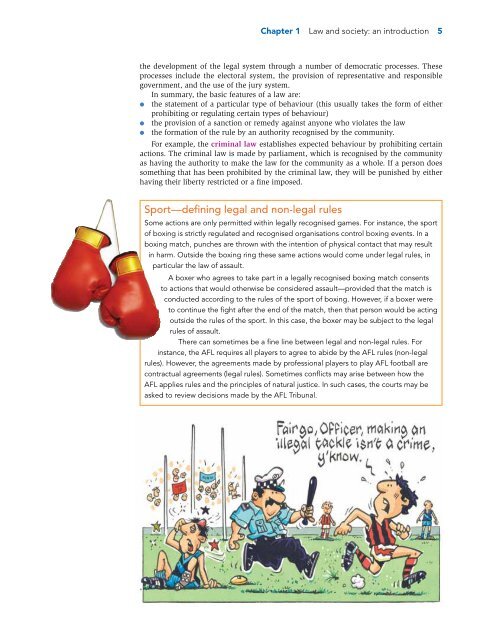Making & Breaking the Law - 9th Edition
Making & Breaking the Law - 9th Edition
Making & Breaking the Law - 9th Edition
- No tags were found...
You also want an ePaper? Increase the reach of your titles
YUMPU automatically turns print PDFs into web optimized ePapers that Google loves.
Chapter 1 <strong>Law</strong> and society: an introduction 5<strong>the</strong> development of <strong>the</strong> legal system through a number of democratic processes. Theseprocesses include <strong>the</strong> electoral system, <strong>the</strong> provision of representative and responsiblegovernment, and <strong>the</strong> use of <strong>the</strong> jury system.In summary, <strong>the</strong> basic features of a law are:● <strong>the</strong> statement of a particular type of behaviour (this usually takes <strong>the</strong> form of ei<strong>the</strong>rprohibiting or regulating certain types of behaviour)● <strong>the</strong> provision of a sanction or remedy against anyone who violates <strong>the</strong> law● <strong>the</strong> formation of <strong>the</strong> rule by an authority recognised by <strong>the</strong> community.For example, <strong>the</strong> criminal law establishes expected behaviour by prohibiting certainactions. The criminal law is made by parliament, which is recognised by <strong>the</strong> communityas having <strong>the</strong> authority to make <strong>the</strong> law for <strong>the</strong> community as a whole. If a person doessomething that has been prohibited by <strong>the</strong> criminal law, <strong>the</strong>y will be punished by ei<strong>the</strong>rhaving <strong>the</strong>ir liberty restricted or a fine imposed.Sport—defining legal and non-legal rulesSome actions are only permitted within legally recognised games. For instance, <strong>the</strong> sportof boxing is strictly regulated and recognised organisations control boxing events. In aboxing match, punches are thrown with <strong>the</strong> intention of physical contact that may resultin harm. Outside <strong>the</strong> boxing ring <strong>the</strong>se same actions would come under legal rules, inparticular <strong>the</strong> law of assault.A boxer who agrees to take part in a legally recognised boxing match consentsto actions that would o<strong>the</strong>rwise be considered assault—provided that <strong>the</strong> match isconducted according to <strong>the</strong> rules of <strong>the</strong> sport of boxing. However, if a boxer wereto continue <strong>the</strong> fight after <strong>the</strong> end of <strong>the</strong> match, <strong>the</strong>n that person would be actingoutside <strong>the</strong> rules of <strong>the</strong> sport. In this case, <strong>the</strong> boxer may be subject to <strong>the</strong> legalrules of assault.There can sometimes be a fine line between legal and non-legal rules. Forinstance, <strong>the</strong> AFL requires all players to agree to abide by <strong>the</strong> AFL rules (non-legalrules). However, <strong>the</strong> agreements made by professional players to play AFL football arecontractual agreements (legal rules). Sometimes conflicts may arise between how <strong>the</strong>AFL applies rules and <strong>the</strong> principles of natural justice. In such cases, <strong>the</strong> courts may beasked to review decisions made by <strong>the</strong> AFL Tribunal.
















